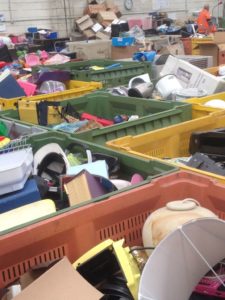Can it be re-designed or improved, or the very least, re-housed?

Tonnes of clothes and household good to be sorted at Good Samaritan Industries

With quick and efficient trade possible in the modern sea container and cheap labor in Asian and African countries, the possibilities for selling cheap consumer items seems limitless. The garment industry is an example. A design for clothing can be ordered for manufacture in China, 1000’s of garments produced and by the time they are sent back for sale in Western countries, the next design is being ordered.
The consumer can hardly keep up with the trend. In earlier times, fashion would arrive as summer and winter collections; with fast-fashion, the changes are week to week and continuous. Where does it all go when fashion changes again?
Op shops and overseas markets are drowning in this cheap fashion – much will end up in landfill. Fashion clothing, as with other goods, is not ‘bad’, and if we value them we want to treasure and appreciate their worth. When we are finished with using them we will want to re-home or dispose of them in a thoughtful way. However, the sheer volume of material goods in our lives often requires conscious effort to keep the quantity to a level where appreciation is still possible!
One destination may be a charity bin, such as Good Samaritans or Salvation Army. These organisations have huge warehouses where clothing and household goods are sorted for sale at the retail outlets, rags for overseas Asian sale or landfill (too dirty or unsaleable-broken goods, odd shoes etc). Some local councils such as the City of Joondalup and The Town of Cambridge are now having clothing collection days where charities take what is dropped off on the day.
Some are recycled as rags and most reused in the collection sorting process for resale or distribution. A fashionable and business opportunity is to recreate new clothing items from old. A clever one started in Perth, by Pia Meehan, Utopia Handmade uses second-hand clothes to re-purpose into fashionable funky kids clothes. She operates on-line and festivals and markets For the resource conscious person, goods made to last can be tricky if they are also considered ‘fashion’ items.
Of course, we don’t want to be unfashionable (unless we are over 40 and don’t care), but then we also want to care and keep the garments maintained. So what to do when we no longer have use for it? Can it be re-designed or improved, or the very least, re-housed? If not maybe we should not have got it to start with?! A report just released again, 2016 Australian Fashion Report viewing the ethical sourcing journey of companies importing clothing into Australia, is a start to investigating issues to be addressed when deciding how clothes are judged for their ethical production, or not. The 2017 Ethical Fashion Guide has been released and can be downloaded free.
In early 2019 there was a fashion summit held in Copenhagen and one of the researchers, Jessica Tadjenko for the annual Ethical Fashion Guide, made comment that ‘the global fashion industry is responsible for 10% of greenhouse gas emissions (by comparison, air travel contributes 1%), its impact on the environment is both a serious and daunting topic’ Jessica also wonders how the fashion industry world would look if we were all personally charged with the recycling/repurposing of all the garments we purchase.






